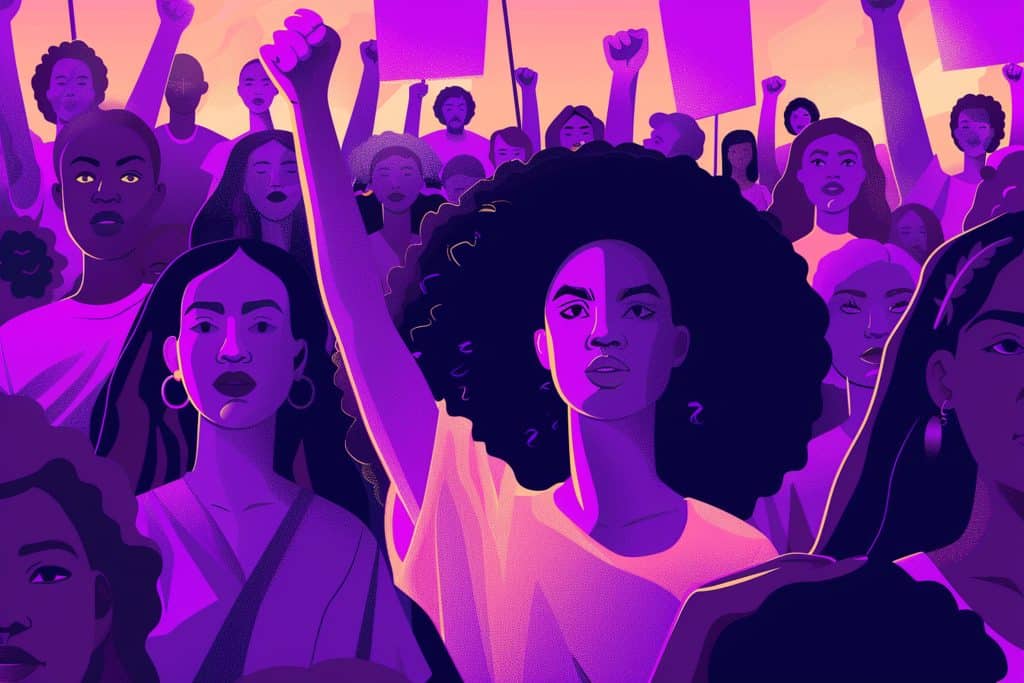women’s rights marches: a call for equality and change

Anúncios
Women’s rights marches are vital events that advocate for gender equality, raise awareness about women’s issues, and drive policy changes through collective action and global solidarity.
Women’s rights marches have played a crucial role in advocating for equality and justice. These events unite diverse voices, inspiring change and highlighting ongoing struggles. Curious about their history and impact? Let’s dive in.
history of women’s rights marches
The history of women’s rights marches is a powerful narrative of struggle and triumph. These marches have been pivotal in advocating for gender equality and justice, uniting voices from diverse backgrounds. Understanding this history helps illuminate the ongoing fight for women’s rights today.
Anúncios
Early Milestones
Women’s rights marches date back to the early 20th century. The first significant event was the 1913 Women’s Suffrage Parade in Washington, D.C. This march galvanized the suffrage movement, bringing attention to women’s voting rights. Many women from all walks of life participated, demanding equal rights.
- 1913 Suffrage Parade in D.C.
- 1917 Silent Sentinels protesting at the White House
- 1920 ratification of the 19th Amendment
The 1960s and 1970s
Fast forward to the 1960s and 1970s, a period marked by a surge in activism. The second wave of feminism emerged, bringing issues such as workplace equality and reproductive rights to the forefront. Events like the Women’s Strike for Equality in 1970 highlighted these demands, gathering thousands of women across the nation.
In this era, marches became a crucial tool for visibility and advocacy. They served as platforms for women to voice their concerns and push for change. The impact was profound and paved the way for significant legislative advancements aimed at reducing discrimination.
Anúncios
Today, the history of women’s rights marches continues to inspire new generations. Each event contributes to a rich tapestry of advocacy. The collective memory of these marches is a testament to the perseverance and strength of activists.
Understanding their historical context not only honors the efforts of those who marched but also highlights the ongoing relevance of their fight.
key moments that shaped the movement
Throughout the history of women’s rights marches, several key moments have significantly shaped the movement. These events have not only marked progress but also highlighted continuing struggles for equality.
The Seneca Falls Convention
In 1848, the Seneca Falls Convention was a landmark event. It was the first women’s rights convention in the United States. Here, activists like Elizabeth Cady Stanton and Lucretia Mott gathered to discuss women’s rights and issues. They produced the Declaration of Sentiments, which outlined grievances and demanded equal rights for women.
- Focus on women’s suffrage
- Empowerment of women to speak up
- Formation of organized movements
The Suffrage Movement
The early 20th century saw a surge in the women’s suffrage movement. The 19th Amendment was ratified in 1920, granting women the right to vote. This victory came after decades of protests and organized efforts. The suffragists used marches to raise awareness and pressure lawmakers.
Marches such as the Women’s March on Washington in 1913 became pivotal. They showcased the determination of women and rallied citizens to support their cause.
The impact of these events resonated beyond voting rights. They laid the foundation for future generations of activists who would continue fighting for every aspect of women’s rights including education, workplace equality, and reproductive health.
the role of social media in activism

Social media has transformed the landscape of activism, especially in the context of women’s rights marches. It serves as a powerful tool for organizing, mobilizing, and raising awareness about critical issues.
Connecting Activists
Platforms like Twitter, Facebook, and Instagram have enabled activists to connect across vast distances. Movements can gain momentum quickly as individuals share information, events, and personal stories. This connectivity fosters a sense of community and collaboration.
- Instant updates on events and initiatives
- Sharing powerful personal stories
- Creating supportive networks for activists
Raising Awareness
Social media plays a crucial role in highlighting injustices faced by women. Hashtags such as #MeToo and #TimesUp have gone viral, spreading messages of empowerment and solidarity. These campaigns spark conversation and encourage more people to join the fight for women’s rights.
Furthermore, social media allows for real-time coverage of events. During rallies and marches, live streaming enables those who cannot attend in person to participate virtually. This approach not only broadens the audience but also increases visibility.
Social media can also amplify marginalized voices, giving women from various backgrounds a platform to advocate for their rights. This inclusivity enriches the movement, showcasing diverse experiences and challenges.
global women’s rights marches and their significance
Global women’s rights marches highlight the unity and strength of women fighting for equality across different cultures and countries. These events symbolize a shared commitment to address injustices and amplify voices that have long been marginalized.
The Rise of Global Movements
Over the years, women’s marches have taken place worldwide, from the United States to Europe, Asia, and Africa. For instance, the Women’s March on January 21, 2017, brought millions together in cities across the globe. This remarkable turnout demonstrated the widespread desire for gender equality and human rights.
- Global participation in major events
- Connection of local issues to global movements
- Solidarity among diverse groups
Impact on Policy and Awareness
These marches do not merely raise awareness; they also drive policy changes. In many countries, the visibility gained from these events has led to legislative reforms aimed at protecting women’s rights. For example, countries such as Spain and Argentina have seen significant discussions around abortion and domestic violence laws influenced by activism from these marches.
Moreover, global women’s rights marches help to educate the public about critical issues such as workplace discrimination and reproductive rights. They foster discussions that inspire action and empathy, making women’s rights a priority in political agendas.
The significance of these marches is also reflected in their ability to unite diverse groups around common goals. They encourage women from various backgrounds to share their stories, creating a tapestry of experiences that enriches the movement.
how you can support women’s rights
Supporting women’s rights is essential for promoting equality and justice in society. Everyone can play a role in this movement, whether through advocacy, education, or direct action.
Educate Yourself and Others
Understanding the issues surrounding women’s rights is a crucial first step. Read books, attend workshops, or participate in webinars that focus on gender equality and women’s issues. Sharing what you learn helps raise awareness.
- Follow organizations that focus on women’s rights.
- Share information on social media.
- Discuss women’s rights topics with friends and family.
Participate in Local Events
Attend local rallies, marches, or community discussions focused on women’s rights. These events create visibility and show solidarity with the movement. Your presence can inspire others to join.
In addition to participating, consider volunteering with organizations that support women. This could include shelters, advocacy groups, or educational programs. Your time and effort can make a real difference.
Financial support is also impactful. Donate to charities that advocate for women’s rights or provide services to underserved women. This helps ensure that these organizations can continue their critical work.
Advocate for Policy Changes
Getting involved in advocacy can lead to significant changes in local and national policies. Write to your elected officials about issues that matter to you, such as equal pay or reproductive rights. Your voice can influence decision-making processes that affect women’s rights.
Engaging in conversations about women’s rights with your network can further amplify your impact. Encourage others to support these issues, creating a ripple effect that fosters broader change.
FAQ – Frequently Asked Questions About Supporting Women’s Rights
How can I get involved in women’s rights activism?
You can participate by attending local events, volunteering for organizations, and sharing information on social media.
What are effective ways to educate others about women’s rights?
Share articles, books, and personal stories that highlight women’s issues, and encourage discussions with friends and family.
How can I support women’s rights organizations financially?
You can donate directly to charities that focus on women’s rights and gender equality.
What role do social media platforms play in women’s rights advocacy?
Social media helps raise awareness, connect activists, and mobilize people for events, making it easier to spread messages and gather support.





